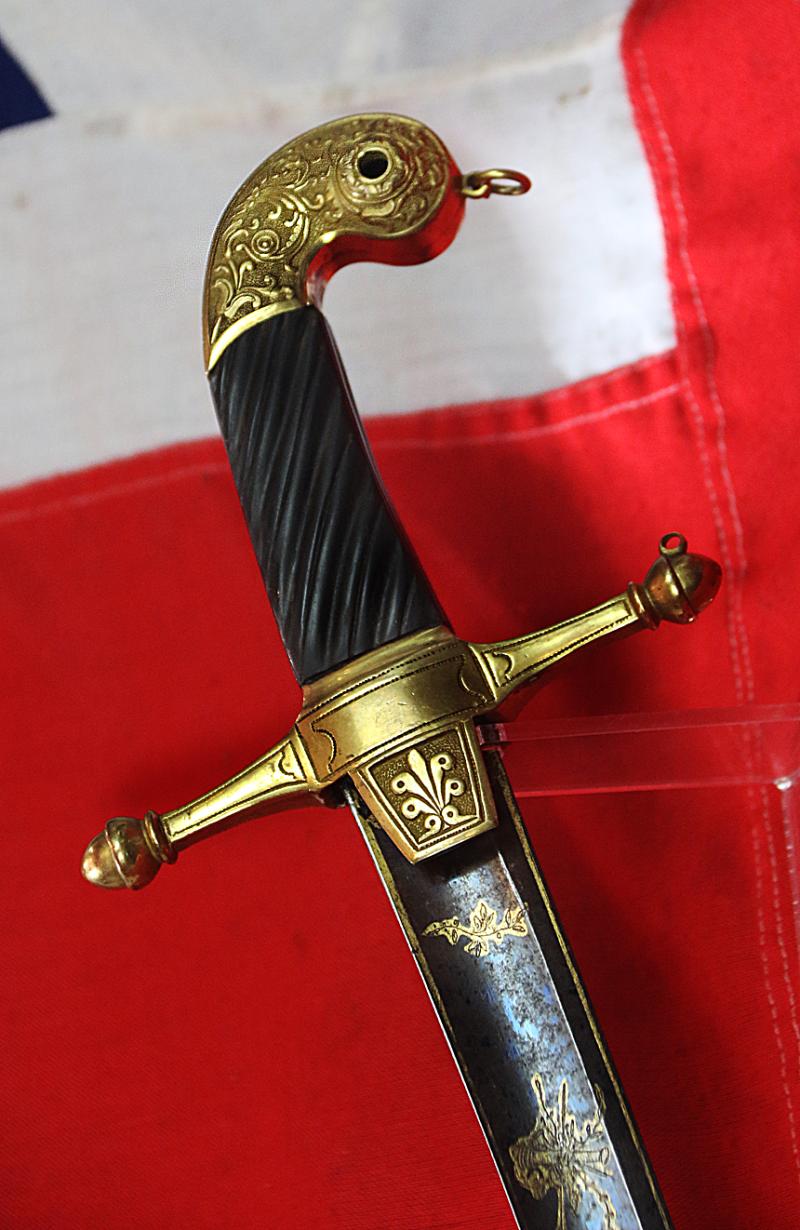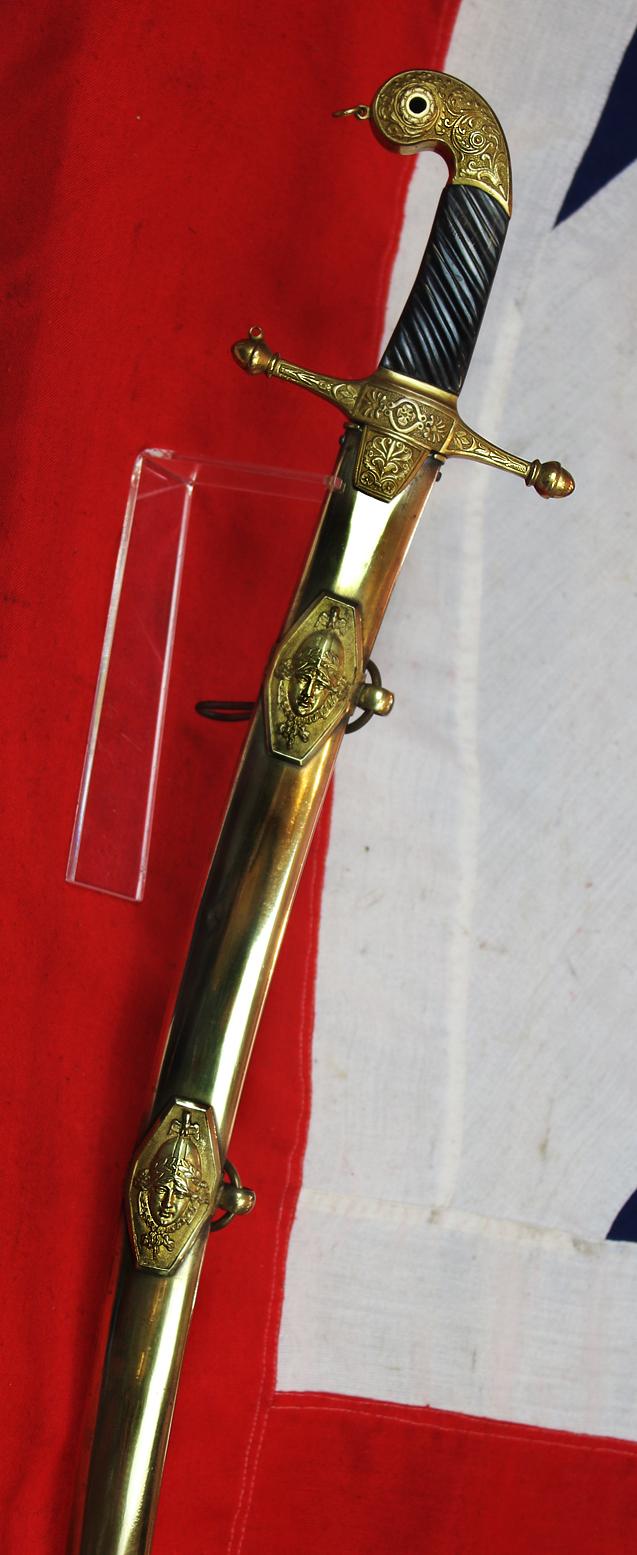A Sublime Napoleonic Ist Empire French Superior Officer’s Blue & Gilt Officer’s Sword in the Mameluke Style, With Finest Deluxe Grade Chiselled Decor. We Always Try Our Utmost To Offer The Finest or Most Intriguing Pieces We Can From History
With copper mercurial gilt hilt and chequered polished horn grip original gilt scabbard with helmeted Minerva head mounts, twin ring belt fittings with its original, multi looped hanging belt chains, with spring catches.
Finely engraved blue and gilt blade.
Napoleon's Egypt Campaign, that ended in 1801, many Napoleonic officer's adopted the so-called oriental mounted swords, modelled on the Mameluke taken by him from Murad Bey, commander of the Mamelukes, which he holds in his Egypt portrait captured from the Egyptian Marmalukes {see gallery} that eventually became part of Napoleons Imperial Garde.
These swords, in their turn, were captured by the British and similarly adopted as a form of highly favoured officers sword. In fact the mamaluke sabre became the British General's pattern sword that is still in use today. Several of these specific swords were part of a Sotheby's Napoleonic Wars auction in Monaco in 1990, titled "Belles Armes Anciennes Casques et Objects Militaires". The last photo in the gallery is of Joachim Napoleon Murat, King of Naples, brother of Napoleon's Mameluke sword, somewhat similar to our sword, and all based on the sword of Napoleon from Murad Bey.
In May of 1804 Napoleon established the French Empire and with it he brought back the title of Marshal of France, also known as Marshal of the Empire at this time. Abolished by the National Convention in 1793, the title of Marshal of France was officially a civilian appointment but reserved for experienced generals. It was an honor to become a marshal and the marshals received higher pay and privileges. Napoleon wished to gain legitimacy in the eyes of Europe since other nations had the rank of field marshal, and he wished to reward and ensure the loyalty of the generals to his empire and thus they wore such swords of this quality and beauty.
One of his greatest marshals to wear such a sword was Marshal
Marshal of the Empire
Étienne Macdonald
duc de Tarente
Étienne Jacques-Joseph-Alexandre Macdonald. During the spring of 1810, Marshal Macdonald was sent to Spain to take command of the Army of Catalonia. While there he won at Ververa, but in 1811 he fell ill and returned to Paris again. In 1812 Macdonald was given command of the X Corps of the Grande Armée for the campaign against Russia. Macdonald's corps missed most of the fighting of 1812 due to being ordered to hold the left flank, but also due to his command being primarily composed of Prussian and German soldiers, with only his headquarters staff being French. Macdonald's corps laid siege to Riga in August, but they lifted the siege in December during the retreat, just in time for the majority of his force to defect away from the French side due to Prussian nationalism.
Napoleon needed experienced commanders for the campaigns of 1813, and in April of that year Macdonald was given command of the XI Corps. He won at Mersebourg and then commanded the right at the Battle of Lützen. Macdonald continued to lead his men into action, winning at Bischofswerda and then commanding the right at the Battle of Bautzen. That August he was placed in charge of multiple army corps but was then beaten by General Blucher at the Katzbach. Nevertheless, Macdonald continued to serve, and he fought at Leipzig , where after the bridge was blown early he had to swim the Elster River to escape capture. After surviving that escape unlike his fellow marshal Poniatowski, Macdonald resumed his command and then fought at Hanau.
Marshal Macdonald served during the defense of France of 1814, initially defending the Rhine but then being forced to fall back to Meaux. That February he fought at Mormant and Ferté-sur-Aube and then in March he fought at Provins and Saint-Dizier. By Napoleon's side, Macdonald along with Marshal Ney convinced Napoleon that he should give up the war and abdicate in favor of his son, Napoleon II. Macdonald, Ney, and Caulaincourt were then sent to negotiate with the Allies, but ultimately they were unable to secure the throne for Napoleon's son. When Macdonald returned to Napoleon to deliver the terms of surrender, Napoleon gave him the sword of Murad Bey, the Mameluke leader that he had defeated in Egypt.
Minerva, whose helmeted face is depicted and seen on the scabbard mounts, is the Roman goddess of wisdom, justice, law, victory, and the sponsor of arts, trade, and strategy. Minerva is not a patron of violence such as Mars, but of strategic warfare.
The blades scabbard has some inside denting at the base, and the blade has some natural age wear to the blue and gilt. Of course this sword’s original owner is now unknown, as none of its history was recorded or saved, however, once accurately known, a sword such as this could be valued anything from treble, to one hundred times its current price, simply depending on how famed he was then or now, or, how important he was to Napoleon and his campaigns. Marshal Nay’s sword for example could easily be valued from one to several million pounds.
Code: 25207
5900.00 GBP










